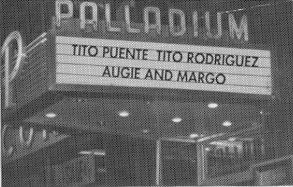Palladium Ballroom
The Palladium Ballroom was located at the northeast corner of 53rd Street and opened on Thursday, March 15, 1946.[1]
- For the later Downtown Club, see Palladium (New York City)

Big Three
In 1948, the Palladium Ballroom gained in stature because of the Big Three acts: Tito Puente, Tito Rodríguez, and Machito. The careers of the Big Three expanded on the strength of their bookings at the Palladium. These bands were turning out mambo hit after mambo hit such as "Asia Minor" and "Babarabatiri", "Picadillo" and "Ran Kan Kan", and "Mambo Mona". Dámaso Pérez Prado's "Mambo No. 5" (1952) was a cross-over hit.
Dancers and dances
The Palladium was known not only for its music but for its dancers, fueled by weekly dance competitions and pie contests along with a Female Best Leg Contest. Ability to dance, not class or color, was the social currency inside the club. The Palladium's top star-performers, Augie and Margo Rodríguez, took the mambo to unimaginable heights. Carlos Arroyo, who partnered with Mike Ramos as The Cha Cha Taps, and also known as Mr Cha Cha Taps is featured in the short film Mambo Madness (1955) Another popular act featured was the group The Mambo and Cha-Cha-Aces with Andy, Mike and Tina. Joe Vega and Freddie Rios did their side by side act. Marilyn Winters danced the entire floor in her one-woman show, as did Carmen Cruz. The Palladium became a showcase for the chachachá, merengue, and the pachanga. These became as popular with the masses as the Mambo.
The year 1948 started the mambo craze that spread across the United States. It began at the Palladium Ballroom. At its height, the Palladium attracted Hollywood and Broadway stars, especially on Wednesday nights, which included a free dance lesson. Dance instructors such as "Killer Joe" Piro — who briefly served as master of ceremonies at the Palladium when Federico Pagani was not available — Augie and Margo were featured dancers there. Pedro Aguilar, better known as Cuban Pete, and Millie Donay appeared internationally. Tito Puente wrote a song for Cuban Pete. Carmen Marie Padilla would offer mass dance lessons for the large audience.
Jazz musicians, celebrities and Latin bands
The Palladium was next to jazz clubs on West 52nd Street such as Birdland, CuBop City, and the Onyx Club. Jazz musicians and some celebrities would sit in and play with the Latin bands. Others watched and enjoyed the show. Examples of notables who went to the ballroom include Count Basie, Marlon Brando, Dave Brubeck, Paul Desmond, Joe Morello, Sammy Davis Jr., Duke Ellington, Ella Fitzgerald, Dizzy Gillespie, Billie Holiday, Gene Krupa, Jerry Lewis, Peter Lawford, Dean Martin, Frank Sinatra, Buddy Rich, George Shearing, Cal Tjader, and Pedro Vargas. Saxophonist Wayne Shorter, who lived in the New York City area during the heyday of the Palladium Ballroom, composed a piece during the 1970s called "Palladium" while a member of the seminal jazz-fusion group Weather Report. The song appears on their Heavy Weather album and features a driving Latin rhythm.
Mambo declines
By the early 1960s, tastes had shifted and it was clear a new sound was on the horizon. The Palladium closed in the spring of 1966. Dancers' and music fans' enthusiasm for the music was not diminished. The Village Gate in Greenwich Village opened to Latin Night on Mondays and Wednesdays. Federico Pagani started Latin Nights with radio host Symphony Sid Torin and Joe Gaines. Pagani started doing the same at Tony Roma's El Corso on 86th Street and Third Avenue, Barney Googles, and the Cheetah, Casa Blanca, Village Gate nightclub. These venues became the places "the scene" went to next. Pagani also was responsible for his input on the movie filming Nuestra Cosa (Our Latin Thing ) at the Cheetah and The Red Garder with Symphony Sid.
Palladium in The Mambo Kings movie
The dance floor and bandstand of the club were recreated in The Mambo Kings (1992), a film starring Armand Assante and Antonio Banderas about the era of the mambo at the Palladium Ballroom and about Federico Pagani. Roscoe Lee Brown played the part of promoter Fernando Pérez, who would listen to what one had to offer in music, could make or break candidates, and was very serious and honest in telling them whether or not they had a chance to make it. Tito Puente played himself, and Desi Arnaz Jr. played Desi Arnaz Sr. The Mambo Kings Band featured Ralph Irizarry, Machito's son Mario Grillo, and others.
References
- New York Post, March 14, 1946; p. 35
Further reading
- Conzo, Joe (October 9, 2004). "The Palladium Ballroom, home of the mambo and cha-cha". Times Herald-Record.
- García, David F. (Spring 2004). "Contesting that Damned Mambo: Arsenio Rodríguez, Authenticity, and the People of El Barrio and The Bronx in the 1950s" (PDF). Centro Journal. XVI (1): 154–175.
- García, David F. (2006). Arsenio Rodríguez and the transnational flows of Latin popular music. Philadelphia: Temple University Press. ISBN 9781592133864. Cf. p. 64 and various (see book index).
- Hutchinson, Sydney (2004). "Mambo On 2: The birth of a new form of dance in New York City". Centro Journal. 16 (2): 109–137.
- "Mambonicks: The Palladium & its Dancers ( Hour 1, Chapter 5". Latin Music USA. Public Broadcasting Service: WGBH. October 2009.
- Rondón, César Miguel & Aparicio, Frances R. (Translator) & White, Jackie (with) (2008). The Book of Salsa: A Chronicle of Urban Music from the Caribbean to New York City. University of North Carolina Press. ISBN 978-0-8078-5859-2.CS1 maint: multiple names: authors list (link) Cf. pp. 1–6 and various (see book index)